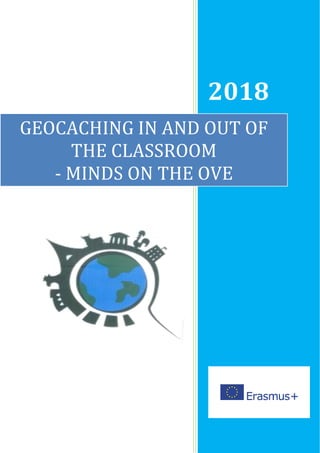The document details a geocaching event organized by Lucie Aubrac High School in Bollène, France, celebrating Erasmus Days 2018, in which students from seven countries participated in creating educational content related to history and gastronomy. It provides a series of challenges related to Lucie Aubrac's life and a gastronomic trail, both part of the Erasmus+ project titled 'Minds on the Move'. Participants must solve questions derived from historical lectures to find cache locations and explore themes of education and history tourism.






































![TYPE FOR THE CALCULATION OF HEART BEATS (H.B.)
PER MINUTE
HB ( maximum ) = [ 220 – age ( years ) ]
HB = 220 - age
HB ( heart beats during exercise ) = [ 220 – age ( years ) ] X 0.70
HB = (220-age ). 70%
HB ( heart beats during exercise ) = [ 220 – age ( years ) ] X 0.85
HB = (220-age). 85%
EXAMPLE:
If you are 40 years old, you will have: 220-40 = 180 beats per minute. In the next step you will need to
identify the target area of your heartbeats. This is determined by counting 75 to 85% of your maximum
heart rate limit. So if we continue with the previous case, that is, you are 40 years old you will have:
1. Maximum heart rate limit 180 pulses / minutes.
2. Multiply 0.70 by 180 and you have 126 beats / minute.
3. Multiply 0.85 by 180 and you have 153 beats / minute.
When you are on exercise, your pulses should be between 126 and 153 beats per minute throughout the
exercise. It is better to start exercising lightly so that the pulses remain at the low limit of the target area.
This will make it possible for you to continue for 20 to 30 minutes without any problems. As time goes
by and you become accustomed to exercise, you have the ability to increase your heart rate to the highest
limit of your target area.
4 HEALTHY LIVING #3 H2O
https://www.geocaching.com/geocache/GC7HGNT_healthy-living-3-h2o?guid=ce2e5f62-2381-40d2-
9fbb-c2b070fa2944
Water molecules were formed in interstellar clouds and came to Earth after the Big Bang. Water has long
been taken for granted as being cheap and abundant, but global threats to its quality and availability are
reframing water as a finite resource in need of close regulation. Around the world, people and societies
are suffering from water scarcity and water pollution.
However, efforts to provide the world with clean and accessible water are made when people try to
determine how much water is actually worth. A healthy and rich environment is essential to provide the
ecosystem services that support our economy, provide us with a good quality of life and provide
resilience to changes in climate. In some countries around the world two out of five women still walk
long distances each day to collect water.
Traditionally bridges have been used as a way for water crossing. Nowadays they are considered a short
way to reach a destination, and therefore bridges are a way to overcome obstacles.
Inspired by the view of the two bridges, this cache focuses on the aspect on water intake hydration.](https://image.slidesharecdn.com/ourcachesi-190102111133/85/Our-caches-i-39-320.jpg)




